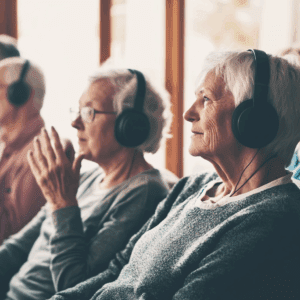Most homes aren’t designed with dementia in mind - but they can be adapted to better support safety, comfort, and dignity. In The Apartment: A Guide to Creating a Dementia-Friendly Home, the Alzheimer’s Foundation of America (AFA) showcases how intentional design, color, lighting, and technology can transform daily living for someone with dementia - and provide much-needed peace of mind for care partners.
This room-by-room guide provides practical insights on how to create a supportive living environment that reduces confusion, increases independence, and minimizes risks, using real examples from a model apartment in AFA’s NYC headquarters.
Why Design Matters
According to the CDC, Alzheimer’s cases in the U.S. are projected to triple by 2060, making dementia-friendly design more important than ever. The Apartment guide starts with this reality and shows that even small environmental changes can improve how a person with dementia interacts with their home and navigates each day.
Room-by-Room Highlights from the Guide
Entryway
-
Use of contrasting colors (e.g. a blue door) and unique decorations (like a red wreath) helps with home recognition
-
Lever handles are easier than twist knobs for people with dexterity issues
-
Shelves for coats and keys placed thoughtfully to avoid wandering triggers
-
Video doorbells and smart locks increase safety and caregiver oversight
Kitchen
-
Smart appliances, clear containers, and see-through cabinet doors support memory cues
-
Safety features include smart burners, fire-extinguishing range hoods, and kettles that auto-shut off
-
Labels and color contrast help with navigation and safety
Dining Area
-
Weighted cutlery, elevated plates, and ergonomic mugs promote easier eating
-
Cushions with contrast and protection improve comfort
-
Color contrast between dishware and table enhances visibility
Living Room
-
Simple remote controls with pre-set channels reduce confusion
-
Large text digital clocks aid time orientation
-
Vintage magazines and calming artwork promote reminiscence and emotional grounding
Bedroom
-
Adjustable beds, memory foam ergonomic chairs, and motion-activated night lighting support safety and rest
-
Clothing labels, corner guards, and user-friendly phones with photo dialing offer both practicality and comfort
-
Lamps with circadian light bulbs help improve sleep
Bathroom
-
Non-slip flooring, grab bars, color-contrasted mats, and night lighting prevent falls
-
Adjustable-height shower heads, transfer bath chairs, and simplified faucets promote independence
-
Bath safety adaptations are subtle but critical to maintaining dignity
Home-Wide Technologies
-
Smart smoke and CO2 alarms that provide voice alerts and app-based updates
-
Motion paging systems to alert caregivers of night-time wandering
-
App-controlled lighting and thermostats mimic natural light cycles to aid mood and sleep
A Holistic Approach to Safety and Comfort
Throughout the apartment, the AFA emphasizes not just utility, but emotional wellbeing. Design choices - like calming colors, minimal clutter, and reminiscent decor - help create a sense of familiarity and reduce agitation. Importantly, the guide reminds readers that the person living with dementia should be involved in setting up these tools whenever possible, to build comfort and trust.
Elli Cares and the Role of Digital Support
At Elli Cares, we share the AFA’s belief that the home environment plays a central role in dementia care. Our app supports independent living with:
-
Visual reminders
-
Scheduled routines and activity prompts
-
Safe Zones and location alerts
-
Family coordination and wellbeing tracking
Together, smart design and smart tools can make daily life feel less overwhelming - and more connected - for those living with dementia.
👉 View The Apartment guide on the Alzheimer’s Foundation of America website








